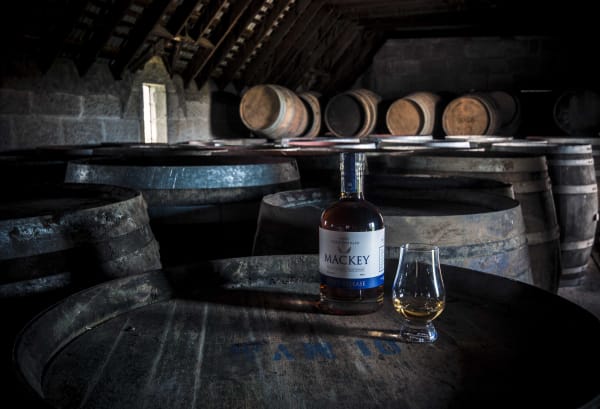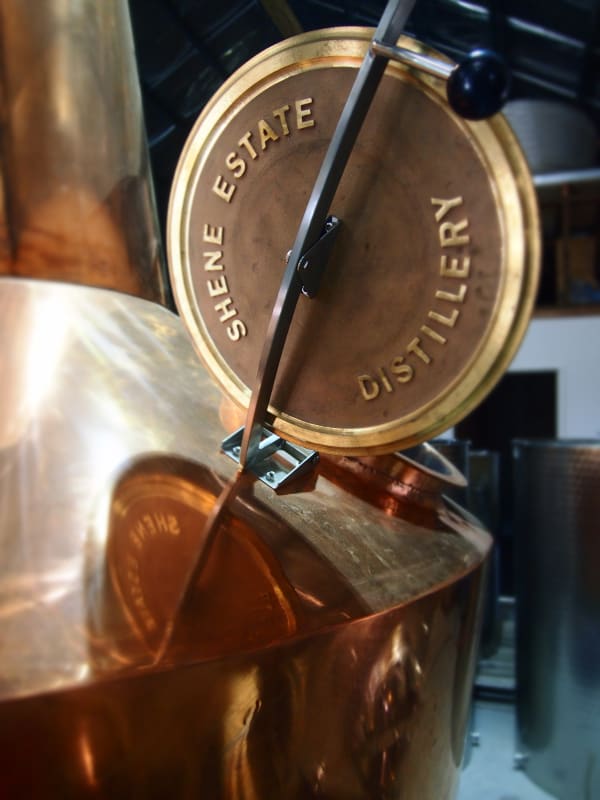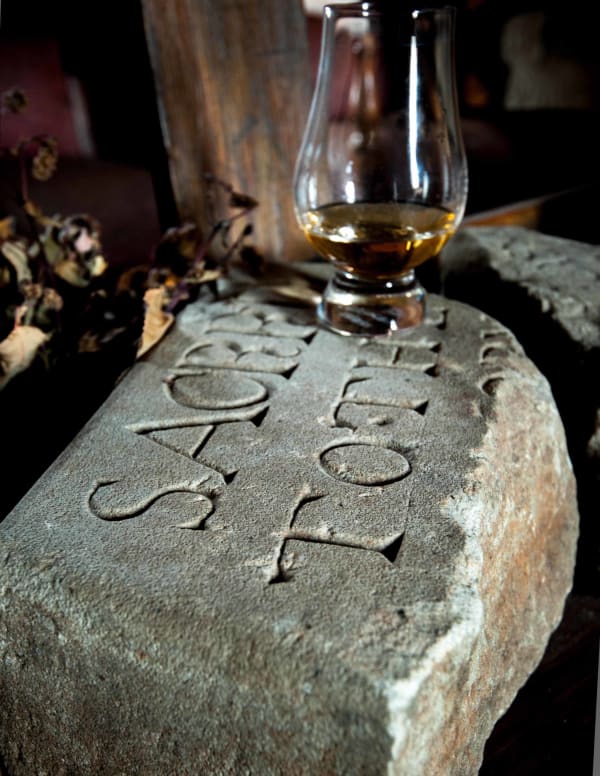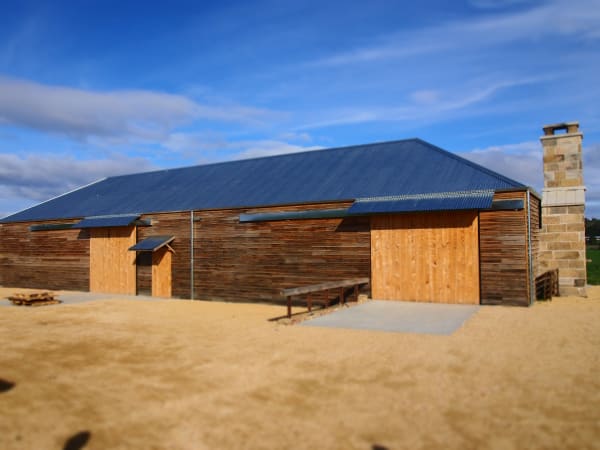Some years ago I was working as a town planner for Hobart City Council when I had to visit a house in New Town to inspect the site of an extension. When I arrived at the house a friendly lady called Madeleine led me straight to a shed out the back and started showing me around a rather impressive backyard distillery that was producing single malt whisky. I thought this was all a bit odd. It turned out she thought I was an environmental health officer and had given me the wrong tour.
Fast forward eight years and Madeleine and Damian Mackey have mastered their single malt and are now also behind the award-winning Poltergeist Gin. The distillery has outgrown its humble beginning and has found a truly amazing home – the Shene Estate.

Damian became interested in making whisky in the early 1990s when he went to work as a land surveyor for Tasmania’s godfather of whisky, Bill Lark. Damian observed first-hand some of the early moments of a Tasmanian whisky industry that is now recognised as one of the best in the world, and in 2014 produced the World’s Best Whisky, a Sullivans Cove single malt.
In 2005, in the shed out the back, Damian began the journey and soon after he and Madeleine established Mackey’s Distillery. Since then they have been patiently perfecting their craft, experimenting with flavours and processes and developing Tasmania’s only triple-distilled single malt.
During the same period the Kernke family was working on a very different project. In 2007, they bought the Shene Estate and immediately began working to conserve this dramatic and unique property. The estate was originally the ostentatious country residence of early settler Gamaliel Butler. There is no other building in Tasmania that looks remotely like it.

The property was an original land grant of 800 acres by Governor Lachlan Macquarie in 1819 to Edward Paine, grandson of King George III. Paine was funded by his brother in law, London lawyer Gamaliel Butler, who also sent with Paine a £10,000 consignment of sugar for sale in the colony.
Edward Paine drowned soon after beginning to establish the land and the property was then controlled by Butler, initially from London, then in Van Diemen’s Land after he and his wife Sarah emigrated in 1824. They left behind in England, in care with relatives, six of their surviving ten children. These children were educated in England and all eventually came to Van Dieman’s Land. They had six more children born in Van Diemen’s Land.
Gamaliel Butler was a wealthy and prominent lawyer in Van Diemen’s Land. Soon after arrival in the colony he was admitted as a practitioner in the Supreme Court and he established his legal firm, which runs to this day (Butler McIntyre Butler). It is the longest-running legal firm in Australasia. Butler also became a director of the Bank of Van Diemen’s Land in 1829 and a founding member of the Commercial Bank.

Their third son Henry achieved eminence as a surgeon, politician and educationalist. Three other sons joined the legal profession. Francis Butler became an architect and it was he who designed the stables at Shene in the style of the Cotswold architecture in England. Some of the buildings on the estate were constructed as early as 1822. The stables, the most stunning piece of architecture on the property, were built in 1851.
The estate’s history has been shaped by regular visits from all sorts of interesting and influential people. John Glover, who lived nearby and was friendly with the Butler family, painted some of his most famous landscapes in the area, including The Bath of Diana and Aborigines Dancing at Brighton.
Mary Morton Allport (1806 to 1895), regarded as Australia’s first professional woman artist, was another visitor. She was the first colonial woman lithographer, etcher and engraver and was close friends with the Butler family, even teaching their daughters the art of painting. Her son Curzon Allport etched his name – which is still visible – in a glass panel of a French door in the front room of the homestead, and a copy of her watercolour Shene Stables with Mount Wellington in the background hangs in the gallery room of the stables.

The estate is included in the Tasmanian Heritage Register and the Register of the National Estate. The official statement of significance on the Register of the National Estate reads: “An outstanding and unique stone stables contrived by Francis Butler and his father Gamaliel Butler as a romantic, picturesque composition. It is a notable example of a Victorian Gothic building influenced by patten books, which makes a memorable impact in the landscape.” It certainly is memorable.
Over the past few years, Kernkes have engaged a huge number of specialists – from archaeologists to stonemasons, earth movers to carpenters – to restore the iconic estate. David and Anne Kernke and their daughters Myfanwy and Ceridwen are not only passionate about conserving the estate, but also in sharing its rich stories. The project is ongoing, but the Shene Estate is now open to the public for the first time in its fascinating history. It has become an extremely popular wedding venue.
“We are inspired by the process of alchemy,” says Anne. “Some may say fragments of old Dutch case gin bottles and patterned dining plates found around the site are worthless. We see a story and a chance to meld these pieces into something more.”

In 2015, the old hayshed was rebuilt to accommodate the Shene Estate Distillery. Head distiller Damian Mackey is busily producing Poltergeist gin in honour of Gamaliel Butler and his vision for the country estate.
With such a rich history, Shene Estate is the perfect home for Poltergeist gin and Mackey Whisky, “spirits which are infused with new flavours and experiences, but preserve the essence of traditional distillation practices.” Only copper pot stills made by Tasmania’s own master still-maker Peter Bailly are used and centuries-old distilling techniques are used.
Poltergeist gin, which is offered both filtered and unfiltered, uses a mix of 12 botanicals gathered locally and from around the world, including Tasmanian native pepper berries, macadamia nuts, star anise and, of course, juniper berries. Damian will tell you the ingredients but will never reveal the balance!
In 2017, the first barrels of Shene Estate Distillery’s Mackey Whisky will also be aged and ready for sale. Mackey has continued to make his unique triple-distilled, unpeated whisky at Shene Estate in much the same way he did in New Town. The mash is made from 100 per cent Tasmanian malted barley and fermentation is by ale yeast. It is the only Tasmanian whisky to be made in the Irish tradition – it is distilled three times in traditional copper pots, then aged in port oak casks prepared down the road in Bridgewater by Tasmanian cooper Adam Bone.
Anne Kernke describes Shene Estate as a historic site with modern ideas. Now with what felt to this visitor like the most natural fit within the estate, the distillery, Shene also invites visitors to share in “a toast to the future from the spirits of the past”.

Learn more about the Shene Estate Distillery by visiting www.shene.com.au
This article was first published in issue 82 of Forty South magazine.
A publisher once told James that when he is asked for his bio, he should say: “James writes subversive essays about important things.” James felt a bit awkward about saying this publicly, but secretly he liked it. He has written for many publications. His books are Essays from Near and Far, Walleah Press, 2014 and The Balfour Correspondent, Bob Brown Foundation, 2017.










